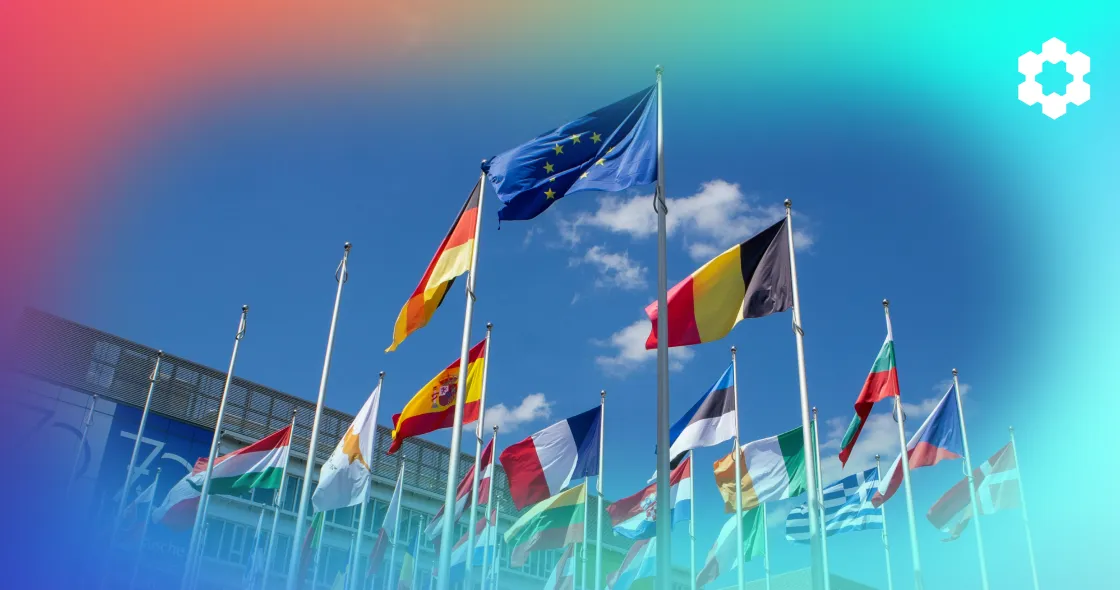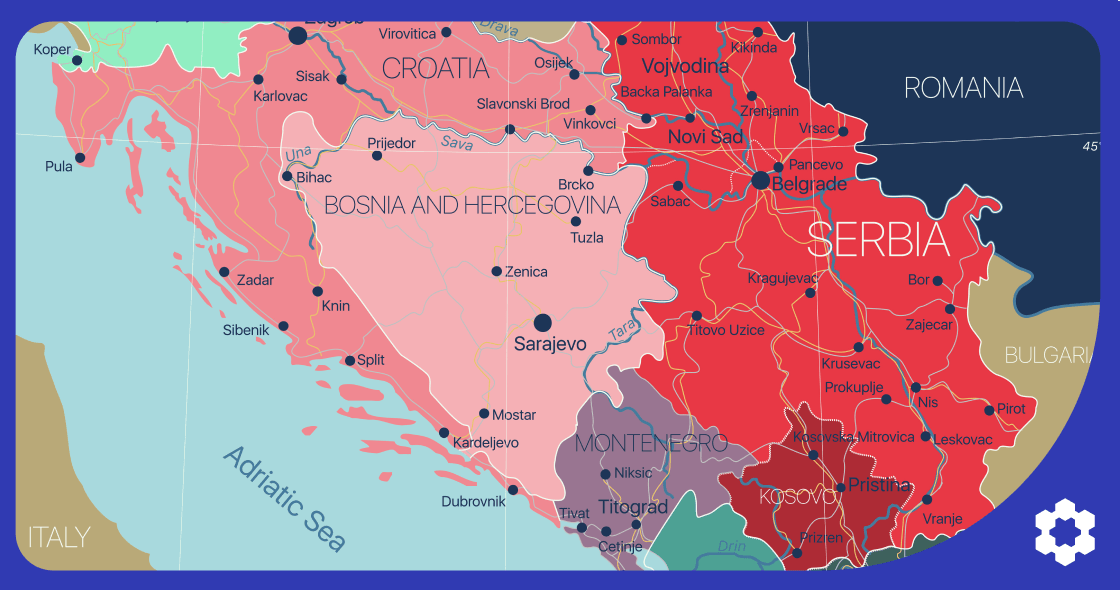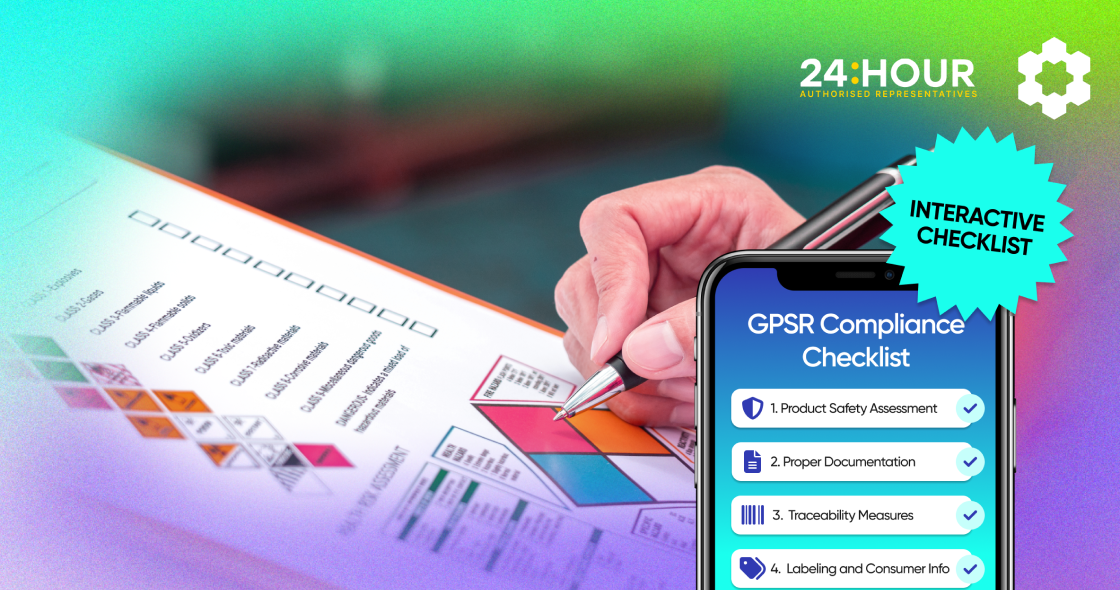Charting a Transatlantic course to dominate the European market? Before you set sail, be aware that expanding from the US to Europe isn’t just about copying and pasting your current strategy into a new setting.
What worked in the US may not work in the European market.
The European Union (EU) and the UK are like a patchwork quilt of different cultures, languages, and regulations. If you want to succeed over here, you’ll need to know the lay of the land.
Major Differences Between the US and EU Markets
Before you dive headfirst into new territory, it’s crucial to understand the major differences between the US and EU markets.
1. Market Size and Diversity
- United States: The US is a giant, with over 330 million people who mostly speak the same language and share a lot of cultural similarities. This makes it easier to streamline your marketing and logistics.
- European Union: The EU, on the other hand, is a collection of 27 countries with more than 440 million consumers. But here’s the catch—it’s far from a unified market. You’re dealing with a mosaic of languages, cultures, and buying habits.
- United Kingdom: Post-Brexit, the UK is doing its own thing now. With over 67 million consumers, it’s still a significant market, but you’ve got to navigate a whole new set of rules.
When I (Ben Leonard) launched my brand, Beast Gear, I quickly learned how much these regional nuances matter.
For example, marketing strength equipment in Germany wasn’t just a simple translation job. The Germans value precision and technical specs, so I had to adapt my messaging accordingly.
In Italy, on the other hand, I dialled up the emotion and passion in my marketing. Bottom line? One-size-fits-all strategies don’t cut it in Europe.
You’ve got to respect and adapt to the diversity of the EU market. Tailor your approach to fit each region if you want to see real success.
Maximise your reach in localised marketplaces with PPC Entourage’s Amazon advertising expertise, designed for sellers in the US, Canada, UK, and select European markets.
2. Regulatory Environment
- United States: In the US, you’re dealing with a single federal regulatory framework, with some additional state-level rules. It’s straightforward once you’ve got the basics down.
- European Union: Europe is a different beast. While there are EU-wide regulations, each country might throw in its own laws on top. For example, the General Data Protection Regulation (GDPR) is a big deal when it comes to data privacy, and getting your product CE marked (especially electronics) is non-negotiable.
- United Kingdom: After Brexit, the UK has its own set of rules, like the UKCA marking that replaced the CE mark. You also have to deal with new customs procedures when moving goods between the UK and the EU.
Navigating these regulations was one of the tougher parts of expanding Beast Gear into the EU. We had to make sure every product met the strict EU standards, like CE marking for our gear, which meant extra work on packaging and labelling. Trust me, it’s worth consulting with experts who know the ropes here.
Make sure you’re up to speed on both EU-wide and local regulations, or you could face fines, product recalls, or worse.
3. Taxation and VAT
- United States: Sales tax in the US varies by state, but it’s pretty simple compared to the EU’s VAT system.
- European Union: VAT is a whole different ballgame. Rates and rules vary by country, and you need to stay on top of registration thresholds. Recent schemes like the One-Stop Shop (OSS) aim to simplify things, but you’ll still need to manage it carefully.
- United Kingdom: If you decide to sell on Amazon UK, note that the country’s VAT system is separate from the EU’s, with its own registration threshold (currently £90,000 – from April 2024 – which is higher than most EU countries), making it more business-friendly for smaller enterprises. Post-Brexit, you also have to pay VAT on goods entering the UK from the EU.
Get your VAT game on point. Accurate handling of VAT is essential for keeping your business compliant and profitable.
4. Logistics and Fulfilment
- United States: Fulfillment by Amazon (FBA) makes shipping and fulfillment across the US a breeze.
- European Union: Logistics in Europe are trickier, thanks to cross-border shipping, varying infrastructure, and different delivery expectations. Brexit adds another layer of complexity.
For example, UK-based sellers need to register for VAT separately in the EU, and goods moving between the UK and EU are now subject to customs checks, potential delays, and additional documentation. Understanding these changes is crucial for maintaining smooth operations and ensuring compliance with the new regulatory landscape. - United Kingdom: With Brexit, shipping to and from the UK has become more complex due to customs checks, potential delays, and the need for separate VAT registration. Businesses should consider leveraging FBA UK centers to streamline logistics. Establishing a local fulfilment center in the UK can help mitigate delays and improve customer satisfaction. Additionally, businesses may need to consider the cost implications of customs duties and longer shipping times when planning their logistics strategies.
As Beast Gear grew, managing logistics across Europe, especially after Brexit, became a serious challenge. We ended up partnering with local fulfilment centres in key countries to keep delivery times down and customers happy.
Plan your logistics strategy carefully. Consider Amazon’s European Fulfilment Network (EFN) and local warehousing to keep things running smoothly.
Your Playbook for a Successful Amazon Expansion in Europe

Understanding the differences is just step one. Here’s how to sell on Amazon Europe:
1. Craft a Strong Brand Identity
European consumers often place a high value on brand authenticity and narrative. They seek brands that meet their values and offer quality and sustainability.
Action Steps:
- Develop a Compelling Brand Story: Craft a narrative that resonates with European values such as sustainability, quality craftsmanship, and social responsibility. Share your brand’s journey, mission, and impact authentically.
- Localise Your Messaging: Localization goes beyond just translating your website and marketing materials—it involves adapting your messaging to resonate with local cultural norms, idioms, and sensibilities. For instance, product descriptions, promotions, and even the product offerings themselves may need to be tailored to align with local preferences and behaviours.
- Consistent Branding Across Channels: Ensure your brand identity is consistent across all touchpoints, including your website, social media, and product packaging. Consistency builds recognition and trust among consumers.
Boost your Amazon ranking, expand your customer base, and unlock new revenue opportunities with PixelMe, Carbon6’s off-Amazon advertising platform.
From the outset, I knew that building an authentic brand was critical to the success of Beast Gear. We centred our brand around values that resonated with our customers, such as quality, durability, and trust.
One of the most gratifying moments was when an MMA fighter chose to wear our mouthguard during a major fight without any endorsement deal. This unsolicited validation was a testament to the brand’s authenticity and the quality of our products.
For European consumers, who often place a high value on brand authenticity, it’s crucial to craft a compelling narrative that aligns with their values. We emphasised our use of high-grade materials and our dedication to helping athletes achieve their best performance, which struck a chord with customers in regions like Germany and Scandinavia, where quality craftsmanship is highly valued. By consistently highlighting these elements in our marketing and product packaging, we built a brand that athletes across Europe trusted and preferred.
Whether it’s a commitment to sustainability or highlighting the craftsmanship behind your products, an authentic brand story can deeply connect with your audience across the EU.
2. Data Is Your Friend
Data-driven decision-making is critical when entering a new and diverse market. Thorough research helps you understand consumer behaviour, preferences, and emerging trends.
Action Steps:
- Utilise Market Research Tools: Employ tools like Google Trends, local market surveys, and social listening to gather insights about consumer interests and market demands in different regions.
- Analyse Competitor Strategies: Study successful competitors in your niche to understand what works and identify gaps you can fill. For instance, consider using SellerTools for optimising your Amazon EU listings. It is a powerful solution that offers competitor keyword insights, automated tools, and a product manager to streamline and elevate your listing management with ease and precision.
- Test and Learn: Launch pilot campaigns in select markets to test your strategies and gather feedback. Use the insights to refine your approach before scaling up.
Drive smarter decision making with D8aDriven’s AI-powered insights and recommendations.
Before launching a new line of products for any of my brands, I pay attention to the market. I want to be developing products that fit both the wider market (e.g., strength and conditioning) but also the geographical market.
Next, tailor your product positioning to however that local market is going to respond best. Or even prioritise ad budgets for different products in different territories, depending on which product is a better fit for which culture!
3. Prioritise Building Consumer Trust
Trust is the cornerstone of consumer relationships, especially in markets where consumers are cautious and value quality and reliability.
Action Steps:
- Secure Local Certifications: Obtain relevant certifications and quality assurances recognized and respected in European markets. This demonstrates your commitment to meeting high standards.
- Encourage and Showcase Authentic Reviews: Collect reviews from early customers and display them prominently. Positive feedback from local consumers can significantly boost trust.
- Provide Exceptional Customer Service: Offer responsive and localised customer support. Address inquiries and issues promptly and in the customer’s native language whenever possible.
In the early days of Beast Gear, establishing trust with our customers was a top priority. We ensured that every product not only met but exceeded safety standards, which was particularly important when we started selling protective gear like mouthguards.
We prominently displayed these certifications on our product pages and went a step further by offering a satisfaction guarantee. Additionally, we set up a responsive customer support system that catered to our growing international audience, which included personalised follow-ups and support in multiple languages.
These efforts were crucial in building a loyal customer base across Europe.
4. Nail Your Logistics
Fast, reliable delivery is key. Use regional fulfilment centres and make sure your shipping policies are crystal clear.
Action Steps:
- Use Regional Fulfilment Centers: Leverage Amazon’s network and consider third-party logistics providers to ensure fast and dependable deliveries across different countries.
- Transparent Shipping Policies: Clearly communicate shipping times, costs, and return policies. Transparency helps set proper expectations and reduces customer frustration.
- Sustainable Packaging: Adopt eco-friendly packaging solutions, which are highly appreciated by European consumers concerned about environmental impact.
To ensure that Beast Gear could offer fast and reliable delivery across Europe, we partnered with strategically located fulfilment centres in countries like Germany and the Netherlands. This allowed us to drastically reduce shipping times and avoid the delays that often come with cross-border logistics.
Furthermore, we adopted eco-friendly packaging not just because it was the right thing to do, but because it resonated with our environmentally-conscious customers, particularly in markets like Scandinavia where sustainability is a major purchasing factor.
Unlock hidden cost savings by tweaking your product and packaging dimensions with Carbon6’s free Product Resizer.
5. Think Long-Term
Don’t just chase quick sales. Focus on building a lasting brand presence by engaging with local communities, creating region-specific marketing campaigns, and adapting based on customer feedback.
Action Steps:
- Engage with Local Communities: Participate in local events, sponsorships, or collaborations that enhance brand visibility and connection with the community.
- Develop Region-Specific Marketing Campaigns: Create marketing initiatives that reflect local holidays, events, and cultural nuances, showing respect and understanding of each market.
- Collect and Act on Feedback: Continuously gather customer feedback and adapt your products and services accordingly. Demonstrating responsiveness to consumer needs fosters loyalty and advocacy.
At Beast Gear, we knew that building long-term trust and loyalty required more than just great products—it required clear, personal communication.
As we execute our Amazon Europe expansion plans, we made it a priority to interact with customers in their native language across all touchpoints.
Whether it was responding to Instagram direct messages, sending follow-up emails, or handling Amazon customer service messages, we ensured that our communications were in the customer’s language. This approach made our international customers feel valued and understood, and it significantly improved our engagement rates and customer satisfaction.
Over time, this commitment to personalised communication helped us build a strong, loyal customer base across Europe.
6. Stay Agile
The European market is dynamic, and staying ahead requires ongoing learning and flexibility.
Action Steps:
- Monitor Market Trends: Keep a close eye on evolving consumer behaviours, economic changes, and industry developments. Adapt your strategies proactively.
- Invest in Professional Development: Encourage your team to understand and appreciate cultural differences through training and exposure.
- Be Prepared to Pivot: Stay open to adjusting your products, marketing, or operations based on real-time feedback and performance metrics.
Throughout Beast Gear’s journey, continuous learning and adaptation were key to staying competitive. I regularly sought feedback from customers and used it to refine our products.
For instance, when we received complaints about the ergonomics of our punch sticks, we didn’t just ignore them; we went back to the drawing board and improved the design. This iterative process of listening to the market and making adjustments based on real-world feedback is crucial in the ever-changing European market.
By staying agile and open to change, you can ensure your brand remains relevant and continues to meet the evolving needs of European consumers.
Don’t Let Compliance Trip You Up: Additional Considerations

Indirect Representation
If you’re not based in the EU, you’ll likely need to appoint an indirect representative. This person (or company) handles customs processes and VAT compliance for you, but here’s the kicker—they do it in their own name, and you’re both on the hook for any legal or financial obligations.
So, don’t just pick anyone. Choose a representative you trust because if they mess up, you’re both in hot water.
Extended Producer Responsibility (EPR)
Selling in the EU isn’t just about getting your product into customers’ hands; it’s about what happens after. EPR regulations, especially in countries like France and Germany, require you to take responsibility for the entire lifecycle of your products—from creation to disposal.
This is especially important if you’re dealing with packaging, electronics, or batteries. Non-compliance? That could mean fines or even having your products yanked off Amazon. And let’s not forget the UK—their EPR rules are evolving, so stay on top of those as well.
OSS/IOSS Registration
If you’re selling across multiple EU countries, the OSS (One-Stop Shop) and IOSS (Import One-Stop Shop) schemes are your new best friends. OSS lets you report all your B2C sales across the EU in one VAT return, cutting down on the hassle of multiple registrations.
IOSS is your go-to for handling VAT on goods imported into the EU with a value under EUR 150, making the process smoother for everyone involved. Getting registered with these schemes is a must if you want to keep your VAT management streamlined and compliant.
Don’t Forget Why You Started
It’s easy to get bogged down in the bureaucracy and lose sight of why you started in the first place. Remember, you’re here to solve problems with exceptional products. As you implement your Amazon expansion strategy, make sure your first product is top-notch—it needs to hit the mark and set the tone for your brand’s reputation.
Nail this from the get-go, especially in such a diverse and demanding market.
Seizing Opportunities in the European Market
Taking your Amazon business from the US to the EU/UK is a journey full of opportunities—and challenges. To succeed, you need to understand and respect the diversity of the European market, build a strong and authentic brand, and stay agile and open to learning.
Focus on what sets your brand apart, use data to drive your decisions, build trust with your customers, optimise your logistics, and always keep the long game in mind. By doing all this, you won’t just enter the European market—you’ll thrive there.
And remember, getting the compliance stuff right is critical. Whether it’s appointing a reliable representative, staying on top of EPR regulations, or leveraging OSS/IOSS to manage your VAT, these steps ensure your expansion is both legally sound and efficient.
So, are you ready to dive into the European market? Equip yourself with the right knowledge, strategy, and a passion for growth, and there’s no limit to what your brand can achieve.








